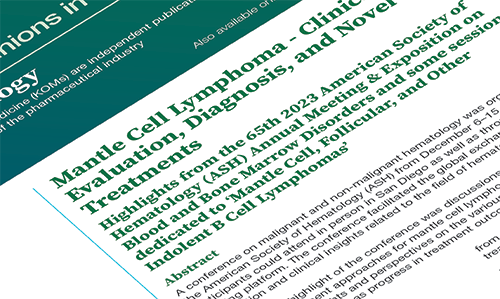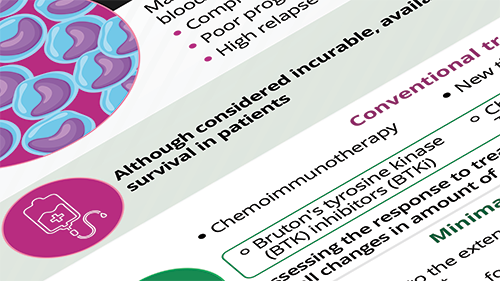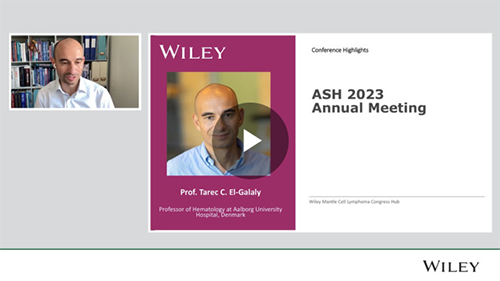Mantle Cell Lymphoma: Current Treatment Practices and Emerging Therapeutic Advances
Highlights from the 29th European Hematology Association (EHA) 2024 Congress focusing on the novel treatment modalities available to patients with newly diagnosed or relapsed mantle cell lymphoma
Abstract
The EHA2024 Hybrid Annual Congress, organized by the European Hematology Association (EHA), was held in Madrid, Spain from June 13 to June 19, 2024, with participants either joining in person or virtually. The program included exciting new content on the diverse treatment strategies available for newly diagnosed as well as relapsed mantle cell lymphoma (MCL).
This article highlights the various treatment modalities and describes the studies evaluating their efficacy, toxicity, and survival benefits in patients with MCL.
Introduction
Mantle cell lymphoma (MCL) is a rare lymphoma with an annual incidence of 1–2 per 100,000, and represents 6%–9% of lymphomas in Western European populations.1 It is commonly diagnosed following lymph node biopsy where the tissue shows the CD5+ and CD19/20+ immunophenotypes, presence of t(11;14)(q13;q32) leading to overexpression of cyclin D1, and expression of the cell proliferation antigen, Ki-67.1
The combined MCL International Prognostic Index (MIPI-c) ensures consistency in diagnosis and discriminates prognostic risk groups based on age, performance status, lactate dehydrogenase levels, leukocyte count, and Ki-67 index.2
Benefits of deferring treatment
MCL can be classified into the nodal, aggressive disease, characterized by SOX11 positivity and high Ki-67, and the other non-nodal, leukemic, and indolent disease, characterized by SOX11 negativity and low Ki-67.1 The indolent cases with low tumor burden do not require immediate treatment, and benefit from a ‘watch and wait’ period.1,3 Martin et al. confirm that the ‘watch and wait’ approach yielded a superior survival profile in the observational group than in the early treatment group, pointing to the advantages of deferring treatment in these patients.4 However, it is challenging to identify the indolent cases, and often additional TP53 mutations cause them to evolve into the more aggressive version.
A study by Eskelund and colleagues showed that TP53 mutations identify a distinct, highly aggressive form of MCL with poor or no response to induction or high-dose chemotherapy regimens, and autologous stem-cell transplantation (ASCT).5 The study underscored the need for novel frontline therapies for patients with TP53-mutant MCL.
Current approach to care
Currently, patients with localized disease (stages I–II), benefit from radiotherapy (RT; 30-36 Gy) and achieve long-term remission. For patients younger than 65 years, first-line treatment involves dose-intensified chemotherapy with rituximab, cyclophosphamide, doxorubicin, vincristine, and prednisolone (R-CHOP), followed by ASCT and maintenance therapy with rituximab.1,3 Patients over 65 years of age are treated with conventional chemotherapy followed by maintenance with rituximab. In the event of relapse, both age groups are offered immunochemotherapy or targeted drugs that inhibit Bruton’s tyrosine kinases (BTKi) or the proteasomes combined with chemotherapy.1
Advantages of prolonged rituximab maintenance
In the routine treatment approach for patients with MCL, the clinical practice of maintenance is critical. Kluin-Nelemans et al. highlighted the benefits of long-term use of rituximab maintenance in older patients responding to R-CHOP, observed as improved progression-free survival (PFS) and overall survival (OS).6 Prolonged use of rituximab maintenance beyond two years was found to be effective and safe.6
A large multicenter study presented by Wang and colleagues further support these findings. They demonstrated that rituximab maintenance after first-line use of bendamustine-rituximab improved event-free survival (EFS) [median: 47.1 vs 29.7 months, adjusted hazard ratio (HR): 0.59, 95% confidence interval (CI): 0.48–0.73] and OS [median: 136.1 vs 74.3 months, adjusted HR: 0.57, 95% CI: 0.44–0.75] in patients with newly diagnosed MCL.7 Together, these data support the use of rituximab maintenance in the clinical practice of MCL therapy. In a phase III trial, rituximab maintenance following ASCT also prolonged EFS (79% vs 61%), PFS (83% vs 64%), and OS (89% vs 80%) evaluated at 4 years, among younger patients with MCL.8
Impact of targeted therapy with BTKi
Inhibition of BTK has revolutionized therapeutics targeting B cell malignancies. BTK is a key signaling protein regulating B cell survival and proliferation. Ibrutinib is a first generation irreversible BTKi. In a randomized TRIANGLE trial, Dreyling et al. investigated the clinical outcomes of adding ibrutinib to immunochemotherapy ± ASCT and to ASCT ± ibrutinib in younger (<65 years) patients with MCL.9 Data presented shows the addition of ibrutinib to first-line therapy and maintenance resulted in superior modified PFS and OS in younger patients. However, ibrutinib resulted in toxicity when given after ASCT. The benefits of combining ASCT together with ibrutinib are unclear. In older patients with MCL, Wang et al. observed superior PFS in the combined ibrutinib and immunochemotherapy group compared to placebo; however, they failed to observe a benefit in OS.10
A randomized phase III trial evaluated the second generation BTKi, acalabrutinib, in combination with bendamustine-rituximab plus rituximab maintenance, against the placebo combination, in older patients with MCL.11 The early results presented from this study indicate a trend towards improved complete responses and overall response rate in the acalabrutinib combination compared to placebo; however, the trial is ongoing and the final verdict is awaited.
Therapeutic advances in relapsed refractory (R/R) MCL
With advances in treatment modalities, there has been a clear improvement in clinical outcomes within the last decade, in patients with R/R MCL. In a prospective cohort study, clinical characteristics, second line treatment details, and outcomes were compared in patients with newly diagnosed MCL from 2002 to 2015.12 The researchers stratified the data according to the period when patients received second-line treatment, between 2003–2009 (Era 1), 2010–2014 (Era 2), and 2015–2021 (Era 3). The results indicated clear improvement in the estimated 2-year EFS rate from Era 1 to Era 3 [21% (95% CI: 13–35), 40% (95% CI: 30–53), and 51% (95% CI: 37–68) in Era 1–3, respectively]. Similarly, the 5-year OS rate was 31% (95% CI: 21–45), 37% (95% CI: 27–50), and 67% (95% CI: 54–83) in Era 1–3, respectively.12 Era 2 and Era 3 marked the advent of BTKi and chimeric antigen receptor (CAR)-T therapy, respectively, which explains the significant improvement in OS.
Newer approved therapeutics are available for clinical use and studies are underway to establish their efficacies and toxicity in patients with MCL. Studies investigating these newer strategies are explored in the following sections.
Covalent BTKi in R/R MCL
Since 2015, BTKi has become the standard of care as the second-line treatment for patients with MCL, with a notable improvement in OS. With the success of ibrutinib, the second generation of BTKi was developed in quick succession. Acalabrutinib and zanubrutinib have fewer off-target effects, less toxicity, and better efficacy. These drugs are well tolerated and serve as convenient oral drugs for R/R MCL.
Data presented by Brown et al., with a head-to-head comparison of the second generation BTKi with ibrutinib in chronic lymphocytic leukemia (CLL), reveals that zanubrutinib has a better safety profile with fewer adverse cardiac events.13 Zanubrutinib also improved the PFS in patients with CLL. Such one-to-one comparisons of the efficacy of BTKis are lacking for MCL. However, given the early results presented from the TRIANGLE trial, it is likely that the second generation BTKi will soon be a part of the first-line therapy for MCL.
Unfortunately, some patients with MCL fail to respond to ibrutinib or acquire resistance with continued treatment. Mutations in the BTK gene or other effectors in the B cell signaling pathway cause primary and acquired resistance to covalent BTKi. Resistance to ibrutinib also means resistance to acalabrutinib and zanubrutinib, due to their shared mechanisms of action.14 Data presented by Rule et al. implied that increase in lines of therapy prior to ibrutinib lead to poor prognosis.15
Impact of BCL2i
Similar to BTKi, B-cell lymphoma 2 inhibitor (BCL2i) monotherapy is known to provide survival benefits in MCL. Results of a single group phase II study by Tam et al. showed that venetoclax, a BCL2i, when combined with ibrutinib improved complete response rates in patients with R/R MCL.16 The dual targeting also reduced the minimal residual disease (MRD) score in these patients.
The phase 3 SYMPATICO trial evaluates the safety and efficacy of concurrently administered, all-oral ibrutinib plus venetoclax in patients with R/R MCL.17 The combination showed improved complete response rates, especially in patients with TP53 mutations.
In data presented by Kumar et al. from a multicenter phase II trial of zanubrutinib, the anti-CD20 obinutuzumab, and venetoclax (BOVen) in patients with treatment-naïve, TP53-mutant MCL, favorable PFS and OS responses were observed.18 The results also showed high rates of undetectable MRD. These exciting findings indicate that this combination is a promising therapeutic for the aggressive TP53-mutant MCL.
Immunotherapy with bispecific antibodies
Dual specificity antibodies that activate CD3-positive T cells of patients and redirect them to eliminate CD20-positive B cells in B cell malignancies are being approved. The novel 2:1 (CD20-CD3) bispecific antibody, glofitamab, is approved for clinical use in diffuse large B cell lymphoma.19 Phillips et al. presented safety and efficacy data for glofitamab in heavily pretreated patients with R/R MCL.20 The results indicate that the monotherapy is reasonably tolerated with clinically significant improvement in PFS and OS.
Newer therapeutics with promising leads include CAR-T, non-covalent BTKi, and relevant combinations.
Conclusion
For patients with MCL and their clinical caregivers, the availability of multiple novel therapeutic modalities that show promising results in early clinical trials provide hope for better clinical outcomes in the future.
References
- Dreyling, M., Campo, E., Hermine, O., Jerkeman, M., Gouill, S. L., Rule, S, … & Ladetto, M. (2017). Newly diagnosed and relapsed mantle cell lymphoma: ESMO Clinical Practice Guidelines for diagnosis, treatment and follow-up. Annals of Oncology, 28, iv62–
- Hoster, E., Dreyling, M., Klapper, W., Gisselbrecht, C., Van Hoof, A., Kluin-Nelemans, H. C., … & Unterhalt, M. (2008). A new prognostic index (MIPI) for patients with advanced-stage mantle cell lymphoma. Blood, 111(2), 558–
- Dreyling, M., & Ferrero, S. (2016). The role of targeted treatment in mantle cell lymphoma: is transplant dead or alive? Haematologica, 101(2), 104–
- Martin, P., Chadburn, A., Christos, P., Weil, K., Furman, R. R., Ruan, J., … & Leonard, J. P. (2009). Outcome of deferred initial therapy in mantle-cell lymphoma. Journal of Clinical Oncology, 27(8), 1209–
- Eskelund, C. W., Dahl, C., Hansen, J. W., Westman, M., Kolstad, A., Pedersen, L. B., … & Grønbæk, K. (2017). TP53 mutations identify younger mantle cell lymphoma patients who do not benefit from intensive chemoimmunotherapy. Blood, 130(17), 1903–
- Kluin-Nelemans, H. C., Hoster, E., Hermine, O., Walewski, J., Geisler, C. H., Trneny, M., … & Dreyling, M. H. (2020). Treatment of older patients with mantle cell lymphoma (MCL): Long-term follow-up of the randomized European MCL Elderly Trial. Journal of Clinical Oncology, 38(3), 248–
- Wang, Y., Larson, M. C., Kumar, A., Hill, B. T., Bond, D. A., Kahl, B. S., … & Martin, P. (2024). Benefit of rituximab maintenance after first-line bendamustine-rituximab in mantle cell lymphoma. Journal of Clinical Oncology, 42(16_suppl), 7006.
- Gouill, S. L., Thieblemont, C., Oberic, L., Moreau, A., Bouabdallah, K., Dartigeas, C., … & Hermine, O. (2017). Rituximab after autologous stem-cell transplantation in mantle-cell lymphoma. New England Journal of Medicine, 377(13), 1250–
- Dreyling, M., Doorduijn, J., Giné, E., Jerkeman, M., Walewski, J., Hutchings, M., … & Hoster, E. (2024). Ibrutinib combined with immunochemotherapy with or without autologous stem-cell transplantation versus immunochemotherapy and autologous stem-cell transplantation in previously untreated patients with mantle cell lymphoma (TRIANGLE): a three-arm, randomised, open-label, phase 3 superiority trial of the European Mantle Cell Lymphoma Network. Lancet, 403(10441), 2293–2306.
- Wang, M. L., Jurczak, W., Jerkeman, M., Trotman, J., Zinzani, P. L., Belada, D., … & Dreyling, M. (2022). Ibrutinib plus bendamustine and rituximab in untreated mantle-cell lymphoma. New England Journal of Medicine, 386(26), 2482–
- Calquence combination regimen demonstrated statistically significant and clinically meaningful improvement in progression-free survival in 1st-line mantle cell lymphoma in ECHO Phase III trial. (2024, May 2). https://www.astrazeneca.com/media-centre/press-releases/2024/calquence-combination-improved-pfs-in-1l-mcl.html
- Bock, A. M., Gile, J. J., Larson, M. C., Poonsombudlert, K., Tawfiq, R. K., Maliske, S., … & Wang, Y. (2023). Evolving treatment patterns and improved outcomes in relapsed/refractory mantle cell lymphoma: A prospective cohort study. Blood Cancer Journal, 13(1).
- Brown, J. R., Eichhorst, B., Hillmen, P., Jurczak, W., Kaźmierczak, M., Lamanna, N., … & Shadman, M. (2023). Zanubrutinib or ibrutinib in relapsed or refractory chronic lymphocytic leukemia. New England Journal of Medicine, 388(4), 319–
- Dostálová, H., & Kryštof, V. (2024). Strategies for overcoming resistance to Bruton’s tyrosine kinase inhibitor zanubrutinib. Hematological Oncology, 42(4).
- Rule, S., Dreyling, M., Goy, A., Hess, G., Auer, R., Kahl, B., … & Wang, M. (2017). Outcomes in 370 patients with mantle cell lymphoma treated with ibrutinib: a pooled analysis from three open‐label studies. British Journal of Haematology, 179(3), 430–
- Tam, C. S., Anderson, M. A., Pott, C., Agarwal, R., Handunnetti, S., Hicks, R. J., … & Roberts, A. W. (2018). Ibrutinib plus venetoclax for the treatment of mantle-cell lymphoma. New England Journal of Medicine, 378(13), 1211–
- Wang, M., Ramchandren, R., Chen, R., Karlin, L., Chong, G., Jurczak, W., … & Tam, C. S. (2021). Concurrent ibrutinib plus venetoclax in relapsed/refractory mantle cell lymphoma: The safety run-in of the phase 3 SYMPATICO study. Journal of Hematology & Oncology, 14(1).
- Kumar, A., Soumerai, J., Abramson, J. S., Barnes, J. A., Caron, P., Chabowska, M., … & Zelenetz, A. D. (2023). A multicenter phase 2 trial of zanubrutinib, obinutuzumab, and venetoclax (BOVen) in patients with treatment-naïve, TP53-mutant mantle cell lymphoma. Blood, 142(Supplement 1), 738.
- Dickinson, M. J., Carlo-Stella, C., Morschhauser, F., Bachy, E., Corradini, P., Iacoboni, G., … & Hutchings, M. (2022). Glofitamab for relapsed or refractory diffuse large B-cell lymphoma. New England Journal of Medicine, 387(24), 2220–
- Phillips, T. J., Carlo-Stella, C., Morschhauser, F., Bachy, E., Crump, M., Trneny, M., … & Dickinson, M. (2024). Glofitamab monotherapy in patients with heavily pretreated relapsed/refractory (R/R) mantle cell lymphoma (MCL): Updated analysis from a phase I/II study. Journal of Clinical Oncology, 42(16_suppl), 7008.




